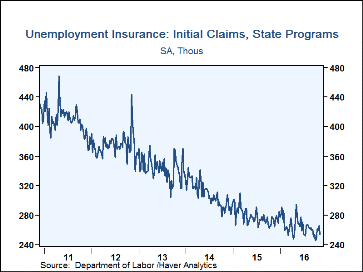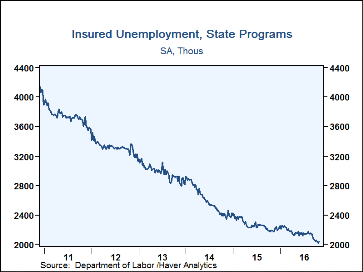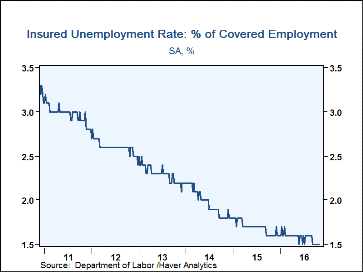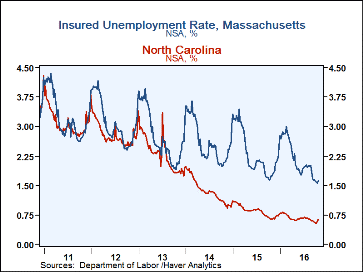 Global| Nov 10 2016
Global| Nov 10 2016U.S. Initial Unemployment Insurance Claims Retrace Earlier Gains
by:Tom Moeller
|in:Economy in Brief
Summary
Initial claims for jobless insurance claims declined to 254,000 (-8.0% y/y) during the week ended November 5 following an unrevised increase to 265,000 claims in the week prior. It was the lowest level of claims in four weeks. The [...]
Initial claims for jobless insurance claims declined to 254,000 (-8.0% y/y) during the week ended November 5 following an unrevised increase to 265,000 claims in the week prior. It was the lowest level of claims in four weeks. The four-week moving average of claims edged higher to 259,750, but remained near the lowest level since November 1973. The Action Economics Forecast Survey expected 260,000 claims in the latest week. During the last ten years, there has been a 75% correlation between the level of claims and the monthly change in nonfarm payrolls.
Continuing claims for jobless benefits increased 0.9% to 2.041 million (-6.6% y/y) in the week ended October 29, and reversed the prior week's increase. The four-week moving average fell to 2.040 million, the lowest point since June 2000.
The insured rate of unemployment held near the record low at 1.5%, for the eighth straight week.
Insured rates of unemployment across states continue to vary. For the week ended October 22, the lowest rates were in South Dakota (0.29%), Nebraska (0.46%), Utah (0.58%), North Carolina (0.64%), Maine (0.74%) and South Carolina (0.77%). The highest rates were found in Illinois (1.56%), Massachusetts (1.62%), Pennsylvania (1.78%), Connecticut (1.99%), New Jersey (2.19%) and Alaska (3.08%). The state data are not seasonally adjusted.
Data on weekly unemployment insurance are contained in Haver's WEEKLY database and they are summarized monthly in USECON. Data for individual states are in REGIONW. The expectations figure is from the Action Economics survey, carried in the AS1REPNA database.
Has the Fed Fallen behind the Curve This Year? from the Federal Reserve Bank of San Francisco is available here.
| Unemployment Insurance (000s) | 11/05/16 | 10/29/16 | 10/22/16 | Y/Y % | 2015 | 2014 | 2013 |
|---|---|---|---|---|---|---|---|
| Initial Claims | 254 | 265 | 259 | -8.0 | 277 | 307 | 342 |
| Continuing Claims | -- | 2,041 | 2,023 | -6.6 | 2,268 | 2,607 | 2,978 |
| Insured Unemployment Rate (%) | -- | 1.5 | 1.5 |
1.6 |
1.7 | 2.0 | 2 |
Tom Moeller
AuthorMore in Author Profile »Prior to joining Haver Analytics in 2000, Mr. Moeller worked as the Economist at Chancellor Capital Management from 1985 to 1999. There, he developed comprehensive economic forecasts and interpreted economic data for equity and fixed income portfolio managers. Also at Chancellor, Mr. Moeller worked as an equity analyst and was responsible for researching and rating companies in the economically sensitive automobile and housing industries for investment in Chancellor’s equity portfolio. Prior to joining Chancellor, Mr. Moeller was an Economist at Citibank from 1979 to 1984. He also analyzed pricing behavior in the metals industry for the Council on Wage and Price Stability in Washington, D.C. In 1999, Mr. Moeller received the award for most accurate forecast from the Forecasters' Club of New York. From 1990 to 1992 he was President of the New York Association for Business Economists. Mr. Moeller earned an M.B.A. in Finance from Fordham University, where he graduated in 1987. He holds a Bachelor of Arts in Economics from George Washington University.










